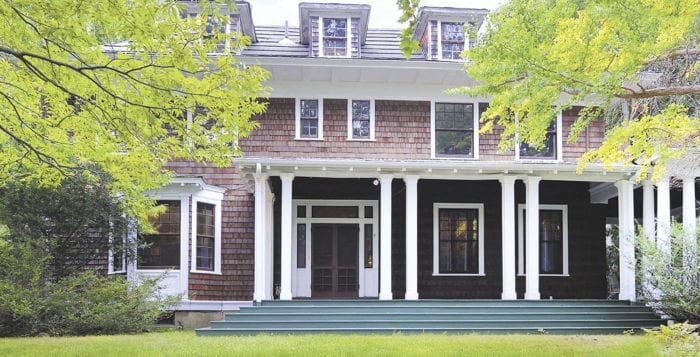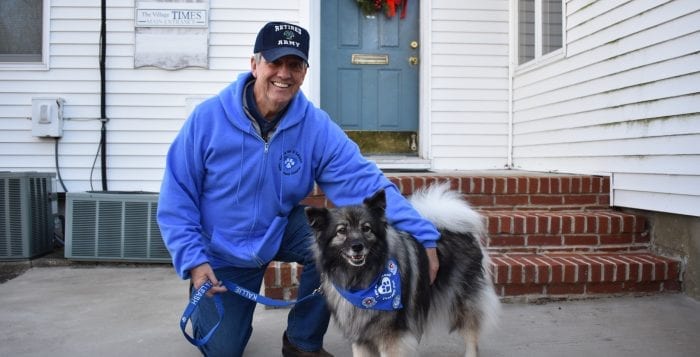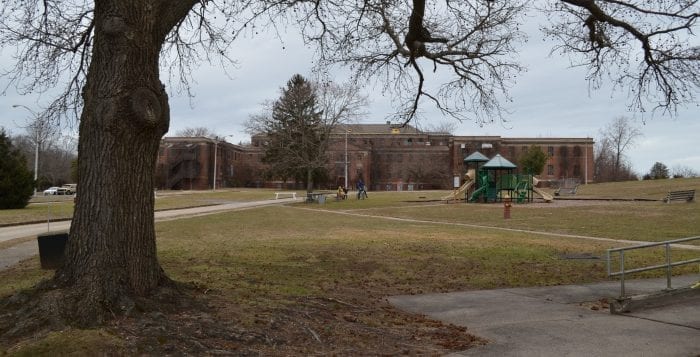Bob Lynch and his dog Kallie are magnetic, or at least it seems that way to watch people come forward, asking gingerly if they can pet the dog, her tail waving frantically.
Coming into the TBR News Media offices, Kallie was the star of the show, and Lynch just let her work her magic. She doesn’t make a sound, instead just walking toward people asking to be petted.
Lynch, a 73-year-old Mount Sinai resident, has been volunteering his time working with therapy dog services for the past several years. He’s owned Kallie, a keeshond, since she was a puppy, and they have been a team for five years. Though he works part time as a risk management consultant, he finds his biggest joy nowadays is taking Kallie where she’s needed most, on a voluntary basis, through the local chapter of Love on a Leash, which provides these services free of charge.
“[Keeshonds] were bred to be babysitters — when they see kids they light up, they love kids, and going to school is perfect for that.”
– Bob Lynch
Kallie has been to nursing homes, veterans homes and hospitals, but where she’s been that her breed might be best at is at schools.
“[Keeshonds] were bred to be babysitters — when they see kids they light up, they love kids, and going to school is perfect for that,” he said. “The work in itself is fulfilling, you walk into a room and see the smiles, and see the demeanor of the people change very quickly.”
Lynch will soon be at the Port Jefferson high and middle schools often as part of a new pilot program in the district that they say will relieve stress among students.
Christine Austen, the assistant superintendent for curriculum and instruction, said she was contacted by Lynch last year and submitted it to the curriculum committee as a pilot, which they approved. The pilot program will run twice a month for four months starting in February and ending in May. A mailer and email will be sent to parents asking them whether they would like to opt out of such visits with the dog, whether it’s from allergies or a fear of animals. Austen said the decision of whether the dog is allowed in certain classes would be treated like allergies.
When presented at the Jan. 14 board meeting, some trustees expressed concerns about safety. Austen said the dog trainer would not be allowed alone with a student at any time and would always have a faculty member present.
Tara Sladek-Maharg, who teaches social studies and psychology in both the middle and high schools, originally brought in a therapy dog for her AP psychology class last year. She had become enthused about the idea of a therapy dog in the classroom after witnessing firsthand what a demonstrably positive effect it had on her own father, when trainer Linda Christian and her dog Murphy, also of Love on a Leash, came to Stony Brook University Hospital and showed him love and compassion after he had a seizure and was going through rehabilitation.
“He goes into rehab and he just sits and goes to each individual person and just lays his head down on them — petting the dog is just so calming,” she said.
Bringing Murphy into the classroom so that the students could review classical conditioning was a transformative experience, Sladek-Maharg said. She has done more research into just why these dogs have such a positive impact on so many. The research shows that being around such dogs has a significant effect on a person’s neurotransmitters and hormones and significantly reduces fear and stress.
Studies have also shown such animals have a positive effect on elementary school students, especially in helping them speak up in public or in class.
“Today our students are very stressed — our staff is very stressed, so having the presence of a dog is just a wonderful outlet,” she said. “They don’t discriminate, especially if they are trained therapy animals. They don’t have any reason to make somebody feel self-conscious, and they have a calming effect on us.”
“Just petting the dog, they get this feeling of unconditional love.”
– Catherine Lynch
Other school districts that have experimented with therapy dogs in classrooms have come away talking of success. Lynch has been a regular at events hosted in the Longwood school district, Miller Place School District and Ward Melville in the Three Village district.
Miller Place High School Library Media Specialist Catherine Lynch brings in therapy dogs once a year during testing to help students relax during such a stressful time. One thing she has noticed is students regularly put away their phones when interacting with the dogs, instead talking and petting the dogs or speaking with each other.
“Just petting the dog, they get this feeling of unconditional love,” she said, adding she would like to see the program expanded to multiple times throughout the school year.
In the Comsewogue school district, special education teacher Tom King has been taking his therapy-trained labradoodle to his classes for years. Last June, during exam season, the district brought in multiple dogs into the school cafeteria to interact with students.
Love on a Leash is a national organization that started in San Diego in the 1980s as a volunteer organization for therapy dogs. The organization has expanded to include chapters across the U.S. and several thousand members. The Long Island chapter was founded about a decade ago and includes over 150 members and just around 25 “active” participants covering Suffolk, Nassau and parts of Queens.
Theresa Schwartz, the chapter president, said schools have been expanding such programs with therapy dogs. When she started about three years ago, schools would ask her to come in during testing times, but that has expanded into doing reading programs in elementary schools, after-school wildlife clubs, SEPTA events and even offering support services during emotionally fraught times, such as when a teacher or a student passes away.
The fact that Love on a Leash is a nonprofit volunteer organization makes the program unique, Lynch said. From the start, people who train the dogs and take them around are also their owners, living with them 24/7, and they have personally seen the ways a dog has helped bring people who are truly suffering a little bit of joy.
“I think I can speak for most of our volunteers doing this kind of thing, [it] makes the team, the dog and the handler, feel better, and makes other people feel better,” she said. “You see what joy your dog can bring to other people.”
Young people in an environment like school, Austen said, respond especially to animals. It has even had a positive impact on faculty.
“It just seems to take down the level of anxiety,” she said. “There are so many instigators of that, whether it’s cellphone use or social media — all of that constant stimulation. Then there are the academics at the high school, and the push to perform.”
If successful, which she expects the program will be, she wants to expand it to the elementary school, where studies have shown therapy dogs have a positive impact on helping people speak up in class.



















